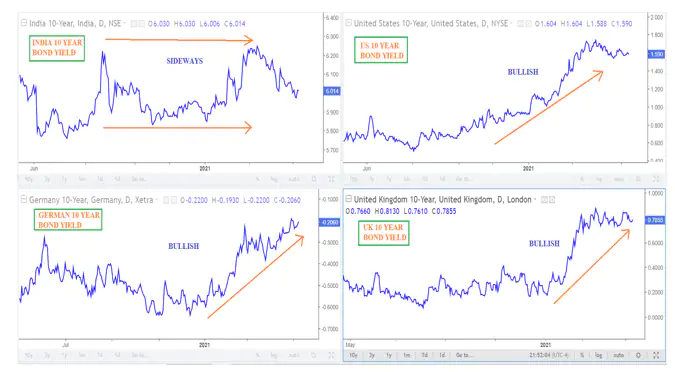- May 11, 2021
- Posted by: Amit Pabari
- Category: Bonds

When you analyse the domestic bond market dynamics then definitely understand that apart from global or domestic fundamental factors, now another factor called RBI is playing a key role in shaping the entire market perception. With no option left, RBI is managing the yield very carefully; one side to support the government’s borrowing program and on another side to remain at par to kick-start investments and borrowing markets. Despite the surge in the US bond yield till March 2021 or weakness in the domestic currency in April 2021, the benchmark yield was seen trading in the tight range of 5.95 percent-6.15 percent. The below factors will surely keep you on your toe and make you rethink the investment strategy into the bond market.
1. The RBI’s bond puppet show
The more structured and refined way of conducting OMO is nothing but G-SAP(Government- Securities Acquisition Programme), under which RBI committed to buy Rs 1 lakh crore worth of bonds in the April-June quarter. Out of that 25,000 bought last month and now they are going to buy 35,000 crore in May. This would definitely rein in a sharp spike in G-Sec bond yields and hence last week yield fell below the psychological 6 percent mark. The ongoing program is likely to further flatten out the yield curve and calm down the trader’s nerve by announcing the program in advance. Overall, the yield rate and curve both are likely to remain under RBI’s hand as they are supporting the government’s elevated borrowing program.
2. How global yields are shaping the curve
In the US, the stock market is trading at All-Time-high, commodities are into supercycle mode, inflation break-even at an 8-year high, personal income & saving rate at record levels, the vaccination program is running smoothly and the economy is expected to re-open quickly than other countries. But still, the fed wants to remain accommodative and continue to buy bonds. If this is not enough then when the fed will turn hawkish? Just like 2020, there are chances that on stronger economic recovery, prospects of rate hike increase in trader’s mind and we could see yield resuming its uptrend. It has to move higher, otherwise inflationary pressure will further deepen real yield into negative territory. In Europe and UK, yields are on their way to move higher as shown in the chart. Obviously, to complete rising global yield, the domestic yield has to be higher to remain competitive and attract flows. But RBI’s strong intervention in the bond market is likely to keep yield in a narrow range. And hence, the India-US yield differential is expected to go down, which will not attract flows into the bond market or we can see outflow from the Indian bond market.
3. What rise and fall in yield mean to equity market
Over a long-term period, the equity market moves opposite direction with the bond yield. The reason being, the rise in bond yield diversifies investment strategy flows back to the bond market to hunt for more return. And hence, the overvalued global equities should start correcting on the shift of flows. This time it seems a repetition of the Taper Tantrum-2013 scenario where flows had gone back to the US treasuries from emerging markets. This could be very much negative for the domestic equities and Indian Rupee.
Conclusion:
In nutshell, RBI will try to keep yield as tight as possible to support higher government programs. In a given scenario, if RBI thinks to turn hawkish and do rate hike then definitely the financial cost of the corporate will rise and if they fail on their covenant then the default rate would rise. Overall, in the current gloomy environment hiking rate will certainly raise credit default swap rates in India and that would be hurting the equity. The global recovery in the yield will make pressure on the emerging bond markets but with no option left to keep yield regularly in check will be the primary motto of the RBI. Hence, we expect that India’s benchmark yield to trade in the tight range of 5.80 percent-6.30 percent zone over the next 1 to 3 months. The RBI, on another hand, is likely to keep the repo rate neutral at 4 percent for an extended period of time to support economic recovery.
-Amit Pabari is managing director of CR Forex Advisors. The views expressed are personal.
Leave a Reply
You must be logged in to post a comment.





